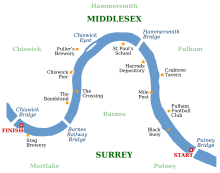The Boat Race 1852
Background
The Boat Race is a side-by-side rowing competition between the University of Oxford (sometimes referred to as the "Dark Blues") and the University of Cambridge (sometimes referred to as the "Light Blues"). The race was first held in 1829, and since 1845 has taken place on the 4.2-mile (6.8 km) Championship Course on the River Thames in southwest London. Oxford went into the race as reigning champions, having defeated Cambridge, who were disqualified, in the previous race held in December 1849. Cambridge led overall with seven wins to Oxford's three.
The universities were unable to agree on a date for race in both 1850 and 1851. The challenge to race from Cambridge was received by Oxford in December 1851 and was finally accepted that a race be conducted around Easter the following year. Oxford were coached by the former Cambridge cox Thomas Selby Egan, who had represented the Light Blues in the 1836, 1839 and 1840 races, in protest at the use of watermen as Boat Race coaches. Oxford had prevented their use since 1841 but Cambridge would not do so until 1873 and were coached by the Thames waterman and world champion sculler Bob Coombes. It was the first time a crew was coached by a member of the other university.
The umpire for the race was Charles Jasper Selwyn and the starter was Edward Searle.
Crews
Three members of the Oxford crew had participated in the previous meeting of the universities in December 1849, Houghton, Joseph William Chitty and the cox, Cotton. None of the Cambridge crew had Boat Race experience. The Cambridge crew weighed an average of 11 st 8.5 lb (73.5 kg), 2 pounds (0.9 kg) per rower more than their opponents.


